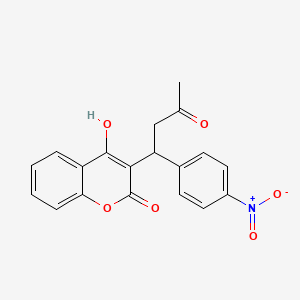D0763 | acenocoumarol
B
B01AA07 Acenocoumarol
[B01AA] Vitamin K antagonists
[B01A] ANTITHROMBOTIC AGENTS
[B01] ANTITHROMBOTIC AGENTS
[B] Blood and blood forming organs
| Toxicity | Dose | Time | Species | Model | Method | Action | Positive criterion | Reference |
|---|---|---|---|---|---|---|---|---|
| MEMBRANE POTENTIAL | 8.36±1.07 | human | qHTS-HepG2 | MMP assay | decrease | IC50 | 163 | |
| MEMBRANE POTENTIAL | 9.32 | human | HepG2 | MMP assay | decrease | IC50 | 163 | |
| MEMBRANE POTENTIAL | 4.59±1.82 | rat | hepatocytes | MMP assay | decrease | IC50 | 163 | |
| Pictogram | Signal | Statements | Precautionary Statement Codes |
|---|---|---|---|
  |
Danger |
Aggregated GHS information provided by 45 companies from 5 notifications to the ECHA C&L Inventory. Each notification may be associated with multiple companies. H302 (100%): Harmful if swallowed [Warning Acute toxicity, oral] H315 (84.44%): Causes skin irritation [Warning Skin corrosion/irritation] H319 (84.44%): Causes serious eye irritation [Warning Serious eye damage/eye irritation] H335 (84.44%): May cause respiratory irritation [Warning Specific target organ toxicity, single exposure Respiratory tract irritation] H360 (11.11%): May damage fertility or the unborn child [Danger Reproductive toxicity] H361 (84.44%): Suspected of damaging fertility or the unborn child [Warning Reproductive toxicity] Information may vary between notifications depending on impurities, additives, and other factors. The percentage value in parenthesis indicates the notified classification ratio from companies that provide hazard codes. Only hazard codes with percentage values above 10% are shown. |
P201, P202, P261, P264, P270, P271, P280, P281, P301+P312, P302+P352, P304+P340, P305+P351+P338, P308+P313, P312, P321, P330, P332+P313, P337+P313, P362, P403+P233, P405, and P501; (The corresponding statement to each P-code can be found at the GHS Classification page.) |
| Organism | Test type | Route | Dose (normalized dose) | Effect | Source |
|---|---|---|---|---|---|
| mouse | LD50 | oral | 1470mg/kg (1470mg/kg) | Therapie. Vol. 11, Pg. 85, 1956. | |
| mouse | LD50 | intraperitoneal | 115mg/kg (115mg/kg) | "Merck Index; an Encyclopedia of Chemicals, Drugs, and Biologicals", 11th ed., Rahway, NJ 07065, Merck & Co., Inc. 1989Vol. 11, Pg. 6, 1989. | |
| rat | LD50 | oral | 513mg/kg (513mg/kg) | "Handbook of Analytical Toxicology," Sunshine, I., ed., Cleveland, OH, Chemical Rubber Co., 1969Vol. -, Pg. 3, 1969. | |
| (+/-)-ACENOCOUMARIN | 1185071-64-0; | 152-72-7 |
| 152A727 | 2-Hydroxy-3-[1-(4-nitrophenyl)-3-oxobutyl]-4H-1-benzopyran-4-one | 2-hydroxy-3-[1-(4-nitrophenyl)-3-oxo-butyl]chromen-4-one |
| 2H-1-Benzopyran-2-one, 4-hydroxy-3-(1-(4-nitrophenyl)-3-oxobutyl)- | 2H-1-Benzopyran-2-one, 4-hydroxy-3-[1-(4-nitrophenyl)-3-oxobutyl]- | 3-(.alpha.-(4-Nitrophenyl)-.beta.-acetylethyl)-4-hydroxycoumarin |
| 3-(.alpha.-(p-Nitrophenol)-.beta.-acetylethyl)-4-hydroxycoumarin | 3-(.alpha.-Acetonyl-4-nitrobenzyl)-4-hydroxycoumarin | 3-(.alpha.-Acetonyl-p-nitrobenzyl)-4-hydroxy-coumarin |
| 3-(.alpha.-Acetonyl-p-nitrophenyl)-4-hydroxycoumarin | 3-(.alpha.-p-Nitrophenyl-.beta.-acetylethyl)-4-hydroxycoumarin | 3-(a-acetonyl-p-nitrobenzyl)-4-hydroxycoumarin |
| 3-(alpha-(4'-Nitrophenyl)-beta-acetylethyl)-4-hydroxycoumarin | 3-(alpha-(p-Nitrophenol)-beta-acetylethyl)-4-hydroxycoumarin | 3-(alpha-Acetonyl-4-nitrobenzyl)-4-hydroxycoumarin |
| 3-(alpha-Acetonyl-p-nitrobenzyl)-4-hydroxy-coumarin | 3-(alpha-Acetonyl-p-nitrobenzyl)-4-hydroxycoumarin | 3-(alpha-p-Nitrophenyl-beta-acetylethyl)-4-hydroxycoumarin |
| 4-Hydroxy-3-(1-(4-nitrophenyl)-3-oxobutyl)-2H-1-benzopyran-2-one | 4-Hydroxy-3-[1-(4-Nitrophenyl)-3-oxobutyl]-2H-1-benzopyran-2-one | 4-Hydroxy-3-[1-(4-nitrophenyl)-3-oxobutyl]-2H-chromen-2-one |
| 4-Hydroxy-3-[1-(4-nitrophenyl)-3-oxobutyl]-2H-chromen-2-one # | 4-hydroxy-3-(1-(4-nitrophenyl)-3-oxobutyl)-2H-chromen-2-one | 4-hydroxy-3-[1-(4-nitrophenyl)-3-oxobutyl]chromen-2-one |
| 70897-81-3 | AB-014/25000129 | AB00513804 |
| AB00513804_02 | AB00527557-09 | AB03786 |
| ACENOCOUMAROL | AKOS015962123 | API0000345 |
| AS-56473 | Acenocoumarin | Acenocoumarol (INN) |
| Acenocoumarol [INN:BAN:NF] | Acenocoumarol [INN] | Acenocoumarol, >=98% (HPLC) |
| Acenocoumarol, United States Pharmacopeia (USP) Reference Standard | Acenocoumarol-d4 | Acenocoumarolum |
| Acenocoumarolum [INN-Latin] | Acenocumarol | Acenocumarolo |
| Acenocumarolo [DCIT] | Acenocumarolum | Acenokumarin |
| Acenokumarin [Czech] | Acitrom | Ascumar |
| BPBio1_000110 | BRD-A65051990-001-03-8 | BSPBio_000100 |
| C19H15NO6 | CAS-152-72-7 | CCG-213077 |
| CHEBI:53766 | CHEMBL397420 | CS-4527 |
| CTK2H8029 | CTK8F7500 | Coumarin, 3-(.alpha.-acetonyl-p-nitrobenzyl)-4-hydroxy- |
| Coumarin, 3-(alpha-acetonyl-p-nitrobenzyl)-4-hydroxy- | D07064 | DB01418 |
| DSSTox_CID_2541 | DSSTox_GSID_22541 | DSSTox_RID_76619 |
| DTXSID00991186 | DTXSID2022541 | EINECS 205-807-3 |
| FT-0660961 | G 23350 | G-23,350 |
| G-23350 | G23350 | GTPL9015 |
| HMS1568E22 | HMS2095E22 | HMS2232P20 |
| HMS3372J11 | HMS3713F17 | HSDB 3201 |
| HY-B1014 | LS-55093 | MCULE-6023926157 |
| MFCD00137816 | MLS000539171 | MLS001074461 |
| Mini-sintrom (TN) | Minisintrom | NCGC00016414-01 |
| NCGC00179658-01 | NCGC00179658-04 | NSC-760052 |
| NSC760052 | Neositron | Nicoumalone |
| Nicumalon | Nitrophenylacetylethyl-4-hydroxycoumarine | Nitrovarfarian |
| Nitrowarfarin | Opera_ID_1500 | Pharmakon1600-01502411 |
| Prestwick0_000110 | Prestwick1_000110 | Prestwick2_000110 |
| Prestwick3_000110 | Prestwick_773 | Q304088 |
| SC-19741 | SCHEMBL1477562 | SCHEMBL33543 |
| SMR000162652 | SPBio_002039 | SR-01000678252 |
| SR-01000678252-3 | Sincoumar | Sinkumar |
| Sinthrom | Sinthrome | Sintrom |
| Sintroma | Syncoumar | Syncumar |
| Synthrom | Syntrom | Tox21_110430 |
| Tox21_110430_1 | Trombostop | VABCILAOYCMVPS-UHFFFAOYSA-N |
| W-108047 | Zotil |

